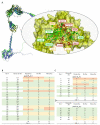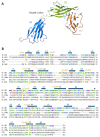The Therapeutic Prospects of Targeting IL-1R1 for the Modulation of Neuroinflammation in Central Nervous System Disorders
- PMID: 35163653
- PMCID: PMC8915186
- DOI: 10.3390/ijms23031731
The Therapeutic Prospects of Targeting IL-1R1 for the Modulation of Neuroinflammation in Central Nervous System Disorders
Abstract
The interleukin-1 receptor type 1 (IL-1R1) holds pivotal roles in the immune system, as it is positioned at the "epicenter" of the inflammatory signaling networks. Increased levels of the cytokine IL-1 are a recognized feature of the immune response in the central nervous system (CNS) during injury and disease, i.e., neuroinflammation. Despite IL-1/IL-1R1 signaling within the CNS having been the subject of several studies, the roles of IL-1R1 in the CNS cellular milieu still cause controversy. Without much doubt, however, the persistent activation of the IL-1/IL-1R1 signaling pathway is intimately linked with the pathogenesis of a plethora of CNS disease states, ranging from Alzheimer's disease (AD), Parkinson's disease (PD), amyotrophic lateral sclerosis (ALS) and multiple sclerosis (MS), all the way to schizophrenia and prion diseases. Importantly, a growing body of evidence is showing that blocking IL-1R1 signaling via pharmacological or genetic means in different experimental models of said CNS diseases leads to reduced neuroinflammation and delayed disease progression. The aim of this paper is to review the recent progress in the study of the biological roles of IL-1R1, as well as to highlight key aspects that render IL-1R1 a promising target for the development of novel disease-modifying treatments for multiple CNS indications.
Keywords: CNS diseases; interleukin-1; interleukin-1 receptor type 1; neuroinflammation; therapeutic target.
Conflict of interest statement
The authors declare no conflict of interest. This review was conducted in the absence of any commercial or financial relationships that could be construed as a potential conflict of interest.
Figures








Similar articles
-
Hepatocyte-specific deletion of IL1-RI attenuates liver injury by blocking IL-1 driven autoinflammation.J Hepatol. 2018 May;68(5):986-995. doi: 10.1016/j.jhep.2018.01.008. Epub 2018 Jan 31. J Hepatol. 2018. PMID: 29366909
-
The IL-1β phenomena in neuroinflammatory diseases.J Neural Transm (Vienna). 2018 May;125(5):781-795. doi: 10.1007/s00702-017-1732-9. Epub 2017 May 22. J Neural Transm (Vienna). 2018. PMID: 28534174 Free PMC article. Review.
-
Cell-Type-Specific Interleukin 1 Receptor 1 Signaling in the Brain Regulates Distinct Neuroimmune Activities.Immunity. 2019 Feb 19;50(2):317-333.e6. doi: 10.1016/j.immuni.2018.12.012. Epub 2019 Jan 22. Immunity. 2019. PMID: 30683620 Free PMC article.
-
Postoperative ileus involves interleukin-1 receptor signaling in enteric glia.Gastroenterology. 2014 Jan;146(1):176-87.e1. doi: 10.1053/j.gastro.2013.09.030. Epub 2013 Sep 22. Gastroenterology. 2014. PMID: 24067878
-
Interleukin-2 and its receptors: Implications and therapeutic prospects in immune-mediated disorders of central nervous system.Pharmacol Res. 2025 Mar;213:107658. doi: 10.1016/j.phrs.2025.107658. Epub 2025 Feb 19. Pharmacol Res. 2025. PMID: 39978656 Review.
Cited by
-
Locus coeruleus injury modulates ventral midbrain neuroinflammation during DSS-induced colitis.Res Sq [Preprint]. 2024 Mar 12:rs.3.rs-3952442. doi: 10.21203/rs.3.rs-3952442/v1. Res Sq. 2024. PMID: 38559083 Free PMC article. Preprint.
-
CSF proteomics in autosomal dominant Alzheimer's disease highlights parallels with sporadic disease.Brain. 2023 Nov 2;146(11):4495-4507. doi: 10.1093/brain/awad213. Brain. 2023. PMID: 37348871 Free PMC article.
-
Interactions and Trends of Interleukins, PAI-1, CRP, and TNF-α in Inflammatory Responses during the Perioperative Period of Joint Arthroplasty: Implications for Pain Management-A Narrative Review.J Pers Med. 2024 May 17;14(5):537. doi: 10.3390/jpm14050537. J Pers Med. 2024. PMID: 38793119 Free PMC article. Review.
-
Mechanism of disturbed endothelial cell function on angiogenesis following ischemic brain stroke (Review).Exp Ther Med. 2025 Jan 29;29(4):61. doi: 10.3892/etm.2025.12811. eCollection 2025 Apr. Exp Ther Med. 2025. PMID: 39991719 Free PMC article. Review.
-
Exploring the common gene signatures and pathogeneses of obesity with Alzheimer's disease via transcriptome data.Front Endocrinol (Lausanne). 2022 Dec 9;13:1072955. doi: 10.3389/fendo.2022.1072955. eCollection 2022. Front Endocrinol (Lausanne). 2022. PMID: 36568118 Free PMC article.
References
-
- Fantuzzi G. Body Messages. Harvard University Press; Cambridge, MA, USA: 2016. 3. Evolution of message discovery: The Interleukin-1 family; pp. 29–73.
Publication types
MeSH terms
Substances
LinkOut - more resources
Full Text Sources
Miscellaneous

